Yonkers Power Station
YONKERS, NY
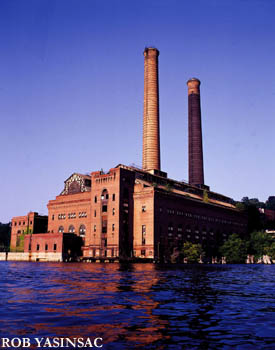
July 2002
|
The Yonkers Power Station
of the New York Central & Hudson River Railroad was constructed between 1904 and 1906. It was built as part of
the electrification of the rail lines spurred in part by dangerous conditions
caused by steam engines and related smoke, and also by the need for a completely
new and larger Grand Central Terminal. The brick power house and two smokestacks
stand as a solitary beacon to Hudson
Valley Ruins as one heads north from New York City. To call this building a ruin, is really a bit unfair however.
For it is still structurally sound enough to accommodate some adaptive reuse
proposal.
However, current residential development proposals
threaten the architectural integrity of the
power station. The power stations remains unprotected as local-landmark legislation
has been pending since an application
was filed in the spring of 2005. In January 2008, the Preservation League
of New York State named the Yonkers Power Station as one of its Seven to
Save Most Endangered properties in New York State.
Please refer to the bottom
of this page for updates regarding the progress of development plans at the Yonkers Power Station.
UPDATED NOVEMBER 14, 2012.
|
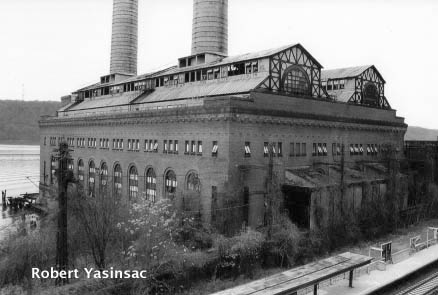
Generating Building. November 25, 2000
Glenwood must
have been quite a sight at the turn of the last century. I wonder what Messrs.
Walter G. Jones and Charles H. MacDonald, whose estates were adjacent to the
east of the Power Station, thought of this edifice. The smokestacks surely made a mockery of the tallest of Mr. McDonald’s “Seven
Pines,” as his estate was named. Their view of the Palisades was obstructed
by progress. The Jones and McDonald mansions are now razed, replaced by
apartment buildings, but not far north is the Glenview mansion, which is
now the centerpiece of the Hudson River Museum. Even the combined wealth
of Mr. John B. Trevor and his business associate and neighbor to the south,
Mr. James. B. Colgate, wouldn’t have been enough to convince New York Central
to build elsewhere.
In 1936 the plant was
sold to a subsidiary of Con Ed, and the railroad was given free electricity for
five years. New York Central then purchased the energy, finding it cheaper than
to make it for itself. The plant doubled as a source of energy for Yonkers and
the surrounding area. The Power Station had “capacity sufficient to
care for the needs of a considerable part of the county” in 1950. I was told a a longtime Yonkers resident that when the long freight trains came
through the neighborhood, TV sets and electric lights dimmed and flickered. The
Yonkers Power Station was put on standby in the 1950s, and closed in the 1960s. The turbines and boilers have all been removed along with all other major
machinery, though much remains to be seen inside. The building was sold to a private party in the
late 1970s and has sat idle and vacant since.
|
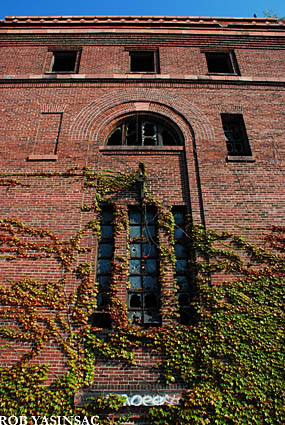
Substation / Transformer Building
|
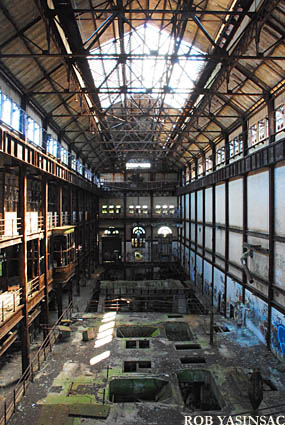
Turbine Room.
|
There actually
are two major buildings here; the smaller substation and transformer building on the north and the main
generating building, which was described as follows by Frank Sanchis, in American Architecture: Westchester County,
New York.
The...plant juts out onto the Hudson River on the west side of
the Hudson Line railroad tracks. The handsome corbelled cornice accentuates
the ponderousness of the building's brick exterior walls. The lower brick
portion is played against a much lighter roof superstructure constructed
of metal members, which are exposed on the facade, and create an unexpectedly
intricate pattern. The power house is topped by two tall, brick stacks,
ringed with circular, metal tie rods.
Ponderousness.
The weight of it all makes one ponder many things. How? Why? What happened
here? . How does a place like this become abandoned? What makes it happen
and why?
The generating building is split into two
sections. The turbine room in the northern half is a cavernous hall, like a great arcade of sorts,
open in the middle, surrounded by walkways on the side, with light filtering
in from the monitor roof above. A giant metal hook emblazoned “1” hangs
above the entrance on the east end. The pit down below is gutted and filled with
pools of stagnant water.
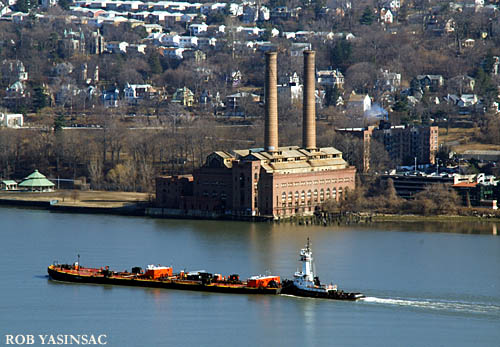
February 2008
The second floor
of this side of the building features the switchboard for the main generators,
behind an operating gallery from which a plant manager could supervise. Other odd remnants of
machinery lay about here and below. A staircase leads up to the third floor,
on which just a small walkway on the east end of the building connects
the two sides. An open-air walkway traverses the space between the generating building
and the substation.
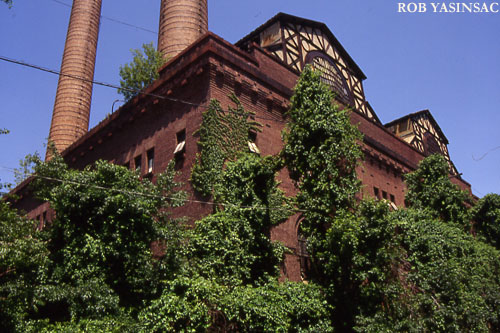
The "Course
of Empire : Desolation" view, as shown in "The
Hudson : America's First River."
ROGER
PANETTA: When I look at this scene, it reminds me of one of the last
in the series of paintings by Thomas Cole in the Course of Empire. In the last
one, there’s a single classical column in which a vine is beginning to grow
back over what is essentially the ruins of the great city. And I look at this,
and this tells me that we’re really at a junction, a transition, between the
old industrial Hudson and a different kind of Hudson. The question is: What
are we going to do with this site and many other sites like that along the
Hudson?
The south side
of the generating building contains the boiler chambers. The room is split into two halves, with an
aisle leading to a view of the Hudson River, directly
opposite the Palisades. On either side of the aisle are individual chambers, the
walls of which have collapsed into large piles of brick. Small rooms at the east
end were offices and bathrooms. The smokestacks and coal bins are supported well
above the ground floor.
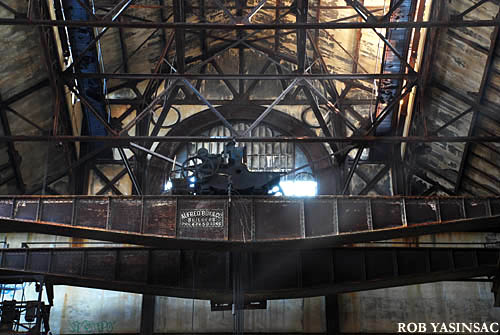
Crane inside the turbine hall.
I'd like to see this
building live another life. In Baltimore,
another power plant has been turned into a retail commercial complex. And in
England, the Bankside Power Station has been turned into Tate Modern,
Britain's new national museum of modern art in London. A monumental power
station in Chester, PA, has been converted to offices. There are numerous
possibilities for reuse that do not involve knocking down the smokestacks and
chopping off the roof and dropping a 30-story glass tower on top.
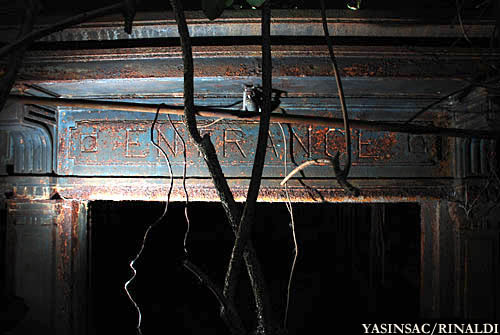
Entrance to the generating building.
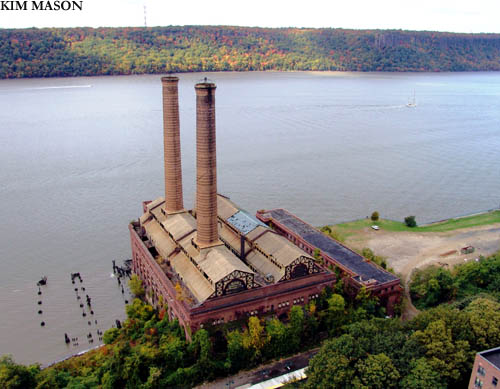
Photograph from the Seven Pines apartment building, courtesy of Kim Mason.
The Yonkers Power Station was sold in
the spring of 2012 to a new owner who is inclined to reuse the buildings.
Subsequently the site was cleared of its overgrowth, marking the first sign of
any official work at this site since the substation closed in the mid-1980s. Ivy
was carefully removed from the walls of the power station and the substation
buildings so that the mortar would be protected from the invasive plant. In
addition to the landscape clean-up and removal of vegetation, engineering
studies are being conducted to determine the integrity of the building and what
if nay repairs must be made. Currently (as of late June 2012) there are no plans
on file at Yonkers City Hall regarding the future development of this site.
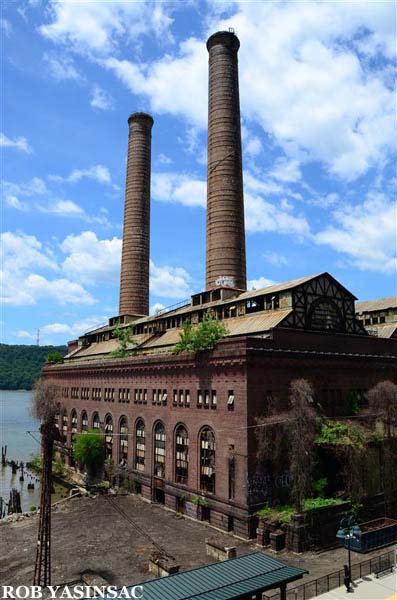
View of the site after the surrounding landscape was
cleaned up. June 2012.
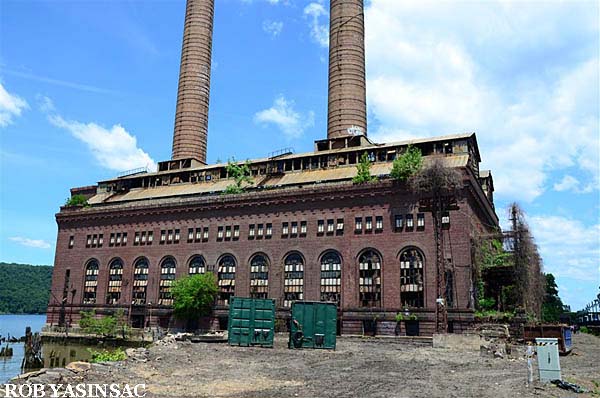
June 2012.
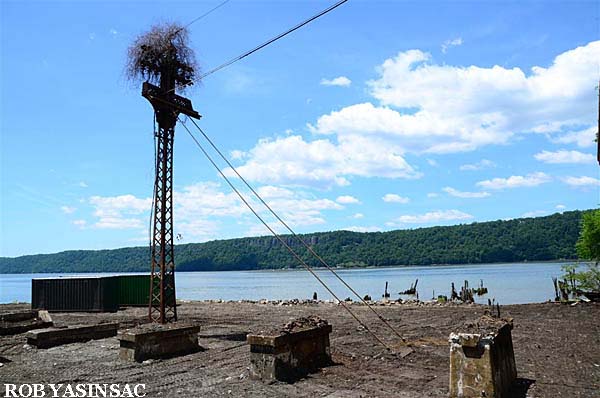
The railroad spur that ran to the edge of the turbine
room has been removed. June 2012.
More Yonkers Power Station photographs:
Summer
2012
March 2007
A few evening photos - April 2007
Hudson
Valley Ruins - Tom Rinaldi's page.
UPDATE: NOVEMBER 12, 2012\
The Journal
News reported yesterday on a plan to redevelop the Yonkers Power Station.
New owner Ron Shemesh and his company Glenwood POH plan to create a hotel and
conference center within the existing buildings of the power station. The
proposal calls for the preservation of the large generating building and for the
construction of two stories to the smaller substation/transformer building. I have
posted current photographs of the power station to my
blog HV-Rob.
UPDATE: JUNE 12, 2012
Cleanup work is occurring in and around the buildings of the Yonkers
Power Station. The property seems to be under contract for sale, and the word I
have received is that plans call for adaptive reuse of the structures. I will
post any details I can as I receive more information. Thanks to reader Mike A. for alerting me to the work at the site. Some photos of the present condition
may be seen at Lost
In Time UE.
UPDATE: JANUARY 30, 2008
The
Preservation League of New York State named the Yonkers Power Station to its
annual list of Seven to Save Most Endangered Places list. The full press release
can be read here.
UPDATE: JANUARY 26, 2008
Please
join us Wednesday January 30, 2008 at the JFK Marina Park Pavilion in Yonkers
for an important announcement by the Preservation League of New York State and
others regarding the Yonkers Power Station.
UPDATE: DECEMBER 27, 2007
The
Yonkers Tribune
announced last week that
developer REMI Companies is withdrawing
its development proposal for the Yonkers Power Station due to financial losses
from the subprime mortgage crisis. Other developers, including Yonkers-based Homes For America Holdings, have expressed interest in
the property.
Source Article: "Subprime Fiasco Claims Glenwood Power Station Developer."
By Hezi Aris, The Yonkers Tribune, December 21, 2007. URL: http://yonkerstribune.typepad.com/yonkers_tribune/2007/12/subprime-fiasco.html#more
Note regarding our Local Landmark application for the power station: The matter is still
sitting with the City Council, which can approve Landmark designation with a
positive vote. The City Council has yet to put the matter to vote, even though
the application was submitted two and a half years ago.
UPDATE: APRIL 7, 2007
Developer
Erik Kaiser of Remi Companies and architect Will Alsop of SMC Alsop publicly unveiled
their plans to develop the Yonkers Power Station site. Their plan to "preserve" what they acknowledged
at the meeting to be a landmark includes the complete removal
of two of the generating building's most iconic features, the smokestacks and
the roof gables. The Yonkers Tribune reported on the meeting of March 30, 2007,
at which the plan was announced. The article contains visual depictions for what
is planned at the site.
Yonkers Tribune - "Metamorphoses of Glenwood Power Plant to BETTER at Glenwood By Hezi Aris."
April 4, 2007.
Architectural
Record News - "Alsop makes U.S. debut in Yonkers." April 3, 2007.
World
Architecture News - "New Plans Revealed." April 4, 2007.
The
Journal News - "Ideas sought for unusual Glenwood development." By
Hannan Adely. March 30, 2007.
The
Journal News - "Yonkers waterfront relic could be reborn." By
Hannan Adely. April 8, 2007.
The
Journal News - "'Green' future in store for Glenwood power plant site."
By Hannan Adely. April 8, 2007.
The
Journal News - "Glenwood project triggers skepticism, enthusiasm."
By Hannan Adely. April 8, 2007.
The
New York Times - "DEVELOPMENT; A New Proposal to Rescue Yonkers' Waterfront."
By Diana Marszalek. April 8, 2007. (Pay for access, but copied here
at a blog site.)
The
New York Times - "Smoke (And Mirrors) On the Water." April 15,
2007. (Pay for access.)
UPDATE: FEBRUARY 17, 2007
"YONKERS POWER STATION: MONUMENTAL RUIN ON THE HUDSON"
Exhibit of Photography by Thomas Rinaldi and Robert Yasinsac
On Display March 3, 2007 to April 19, 2007
Beczak Environmental Education Center
http://www.beczak.org/
35 Alexander Street
Yonkers, New York 10701
(914) 377-1900
Gallery Hours: Monday - Friday, 9am - 5pm. The Beczak Center also serves as a classroom; call before you visit to make sure no activities
are in session. Fridays are class-free days and a very good time to visit.
UPDATE JANUARY 3, 2007
The Yonkers Tribune reported today that REMI
Companies hosted a public meeting with area residents to gain input regarding
the future of the Yonkers Power Station property. The meeting was held December
14, 2006 and featured architect Will Alsop and Yonkers City Council Majority
Leader Pat McDow. Supposedly this was the first step in the "process in which public input and dialogue would be promoted."
Details can be found at the Yonkers Tribune website. I will however, excerpt,
from the press release, by REMI Companies here: "The residents agreed with Alsop that the landmark building was worthy of preservation for residential and commercial uses."
Here they refer to this building as a landmark but have thus far opposed having
the building actually be declared a city landmark.
Source Article:
Yonkers
Tribune - "Public Hearing Conducted over Future of Glenwood Power Station."
January 3, 2007.
UPDATE: AUGUST 15, 2006 - Yonkers Power Station Exhibition Announcement
"YONKERS
POWER STATION: MONUMENTAL RUIN ON THE HUDSON"
Photographs by Tom Rinaldi and
Rob Yasinsac
The Municipal Art Society of New York http://www.mas.org/
September 7, 2006 through November 1, 2006
Opening Reception: Tuesday, September 12, 6:00pm – 8:00 pm.
The Gallery is open Monday through Saturday, 11:00 am to 5:00 pm.
Postcard can be downloaded
here as a .pdf file.
Built
to supply electricity to trains headed to Grand Central Terminal, Yonkers
Power Station is a testament to the industrial heritage of the Hudson River
and is a prime candidate for adaptive reuse. This exhibition of photographs is
accompanied by a new book, Hudson Valley Ruins: Forgotten Landmarks of an
American Landscape.
UPDATE: JULY 14, 2006
World
Architecture News has reported that Remi Companies has commissioned SMC
Alsop to design a residential and museum component to the Yonkers Power Station.
The announced project completion date is 2008.
UPDATE: JANUARY 31, 2006
The LWRP public meeting schedule for February 2nd at 7pm has been cancelled
and will be rescheduled. The Steering Committee meeting will still be held
starting at 5pm and the public may attend as
observers.
UPDATE: JANUARY 30, 2006
A public meeting on the proposed Yonkers Local Waterfront Revitalization
Program (LWRP) will be held on Thursday, February 2nd at 7:00pm at the Yonkers
Downtown Waterfront Library, 2nd Floor.
The LWRP is a key comprehensive "concept document" that outlines the
City's vision for waterfront redevelopment. The draft document is 323
pages long and can be viewed at the City of Yonkers website: http://www.cityofyonkers.com/LWRP/lwrp%201-23-06.pdf.
The document provides official recognition from the city that this building
should be a part of Yonkers' future by touting the adaptive reuse potential of
the Yonkers Power Station.
UPDATE: NOVEMBER 7, 2005
On November 2, 2005, the Yonkers Landmarks
Preservation Board voted unanimously to recommend local Landmark status for the
Yonkers Power Station. Previously the Yonkers Planning Board voted against
recommending Landmark status. The Landmarks board voted on the technical merits
of the application citing the history of the power station and its contribution
to local and regional patterns of growth, that the architecture of the building
is unique and distinct and is best protected through landmark status, and that
adaptive reuse of similar power plants around the world have successfully transformed
abandoned buildings which spurred local redevelopment. The City Council will
next vote on official Landmark status.
UPDATE: AUGUST 11, 2005
Deirdre Hoare, Martin McGloin and myself presented
our application for City Landmark Status for the power station to the Planning
Board Wednesday night. They did not
vote on the matter so that may happen at the September Planning Board meeting.
Erik Kaiser of Remi Companies spoke against Landmark Status.
Remi is under contract to purchase the site from K. Capolino Construction. While
Kaiser seems to thoroughly enjoy and appreciate the architecture of the power
station and other historic properties, he spoke of the (mistaken, in my opinion)
belief that landmark status would interfere with a project that has been
underway for some time, a belief also held by Yonkers City officials. (This
project was not announced to the public until after our Landmark application was
submitted to the City of Yonkers.) The Landmark Preservation Board has made it
very clear to the Yonkers City Council that it is their intention to work with
owners of historically significant properties to bring their sites back to life
and become a vibrant part of the new communities that are being built or
redeveloped, not to hinder redevelopment and make these sites stagnant. It
is unfortunate that city officials do not recognize this, and continue to be
detrimental of recent landmark efforts, as the mayor's spokesperson was quoted
in the Sunday edition of the New York Times. Kaiser also made the
surprise announcement that a demolition order for the building has been issued,
with demo expected in September, but that he would like see what could be
salvaged from the building and perhaps
incorporate much of it into a new structure. I'll
have updates on whether this demolition actually moves forward.
EDIT AUGUST 13, 2005: Apparently, from what we have been told by the
Yonkers Building Department, there is *no* demolition order on file, and if the
city did issue one, the city would have to pay for demolition - an unlikely
scenario. There are violations on file, and what the city did do was ask for
meeting (call to court?) the owner or developer to find out why the violations
have not been corrected, including why building has not been secured against
trespassing etc. So it looks like Glenwood is hanging on a while longer, though
how long is anyone's guess.
The
Yonkers Tribune - Hezi Aris' review of the August 10,
2005 Yonkers Planning Board meeting.
UPDATE: JULY 27, 2005
The Yonkers Planning Board will review the application to landmark the
Yonkers Power Station at its next meeting, Wednesday August 10. The Journal News
ran a story with positive quotes from two Yonkers' residents in its July 26,
2005 edition, entitled "Landmark Status Sought for Yonkers Power
Plant," by Ernie Garcia.
UPDATE: JUNE 8, 2005
On Wednesday, June 1, the Yonkers Landmarks Preservation Board accepted
our application to locally landmark the Yonkers/Glenwood Power Station as
complete, starting the review process. Next, the Planning Board and Landmarks
Board must make recommendations before the City Council votes on designation. At
the meeting, Remi Companies of New Jersey announced that they are in contract to
buy the building. Remi has stated their intention to demolish the power station,
although no definitive plans have been presented to the public.
UPDATE: MAY 8, 2005
I have changed the references from "Glenwood Power Station" to "Yonkers
Power Station." This more accurately reflects the New York Central history. The
earliest references state simply the "Yonkers power station" or
"power house at Yonkers." An early trade journal names the site the
"Yonkers Power Station of the New York Central & Hudson River
Railroad." The use of "Glenwood Power
Station" does not appear to become
common until the mid-20th century.
UPDATE: MAY 3, 2005:
On Wednesday April 20, I, along with two Yonkers residents, submitted an
application for Landmark designation of the Yonkers Power Station to the City
of Yonkers Planning Department. The first step in the landmarking process is for
the Landmarks preservation Board to review the application for completeness and
then move to accept it and set the process in motion. The Landmarks board review
was scheduled to occur Wednesday May 4, 2005. It was pulled from the agenda on
Monday May 2, by Lee Ellman, head of the Planning Department. Clearly, this was
not supposed to happen. It seems that City Hall is not interested in community
input for redevelopment projects. One of criticisms of the Boyce Thompson
application was that it was preceded by development plans. That excuse
(ridiculous as it is, since we were opposed to the demolition of the BTI
complex, when all other proposals not selected called for reuse of the main
building from the beginning) cannot be used this time, despite efforts by City
Hall to delay our application.
An application was also submitted by another party, and withheld from review by
the Planning Department, for the Yonkers Pier, which the City would like to see redeveloped
as a restaurant. This is the last remaining Pier of its kind in the Hudson
Valley.

Yonkers
Ruins homepage
Yaz’
Hudson Valley Ruins and Abandoned Buildings, etc.
E-mail
Rob Yasinsac
This page copyright © 2007 by Robert
J. Yasinsac.
Copying or reproducing these images without the permission of Robert Yasinsac is
prohibited.
Thanks to Jim Logan for providing
transportation on the Hudson River.












